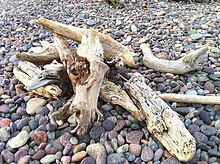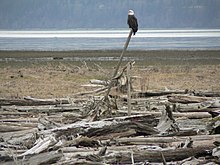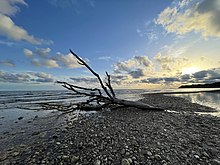Driftwood
Driftwood is wood that has been washed onto a shore or beach of a sea, lake, or river by the action of winds, tides or waves.
Gribbles, shipworms and bacteria decompose the wood and gradually turn it into nutrients that are reintroduced to the food web.
Most driftwood is the remains of trees, in whole or part, that have been washed into the ocean, due to flooding, high winds, or other natural occurrences, or as the result of logging.
According to Norse mythology, the first humans, Ask and Embla, were formed out of two pieces of driftwood, an ash and an elm, by the god Odin and his brothers, Vili and Vé.
[8] The government of British Columbia also advises against burning driftwood, as dioxins may be released from the reaction of chloride ions with other materials in the smoke.
Large diameter Sequoia sempervirens logs spent enough time exposed to wave action to round their contours before being driven into the mouth of a narrow ravine by storm surf.
Sequoia's high tannin content is resistant to decay, so these logs retain structural strength for decades.
[12] Likewise, when traveling in Dixon Entrance in the late 1800s, George A. Dorsey recorded that many beaches were "piled high with drift, often to a height of sixty feet or more.






